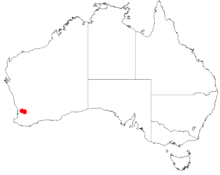Acacia brachypoda
| Western Wheatbelt wattle | |
|---|---|

| |
| Scientific classification | |
| Kingdom: | Plantae |
| Clade: | Tracheophytes |
| Clade: | Angiosperms |
| Clade: | Eudicots |
| Clade: | Rosids |
| Order: | Fabales |
| Family: | Fabaceae |
| Subfamily: | Caesalpinioideae |
| Clade: | Mimosoid clade |
| Genus: | Acacia |
| Species: | A. brachypoda
|
| Binomial name | |
| Acacia brachypoda | |

| |
| Occurrence data from AVH | |
| Synonyms | |
Acacia brachypoda, known colloquially as western wheatbelt wattle or Chinocup wattle, is an endangered species of Acacia restricted to a small locality in western Australia's wheatbelt.[2][3]
Description
The slightly aromatic shrub has a dense rounded habit and typically grows to a height of 1 to 3 metres (3 to 10 ft) and a width of 1 to 4 m (3 to 13 ft).
Taxonomy
The species was first formally described by the botanist Bruce Maslin in 1990 as part of the work Acacia Miscellany. Three new Western Australian species with affinities to A. wilhelmiana (Leguminosae: Mimosoideae: Section Plurinerves) from Western Australia as published in the journal Nuytsia. It was reclassified as Racosperma brachypodum by Leslie Pedley in 2003 then transferred back to the genus Acacia in 2006.[4]
Distribution
The shrub is
Conservation status
The species was list as endangered in 2008 under the Environment Protection and Biodiversity Conservation Act 1999 and was previously also listed as endangered under Schedule 1 of the Endangered Species Protection Act 1992 In Western Australia it listed as rare flora under the Wildlife Conservation Act 1950 (Western Australia) and appears on the Wildlife Conservation (Rare Flora) Notice 2006.
See also
References
- ^ .
- ^ Department of Biodiversity, Conservation and Attractions.
- ^ a b c d e Australian Government: Species Profile and Threats Database Acacia brachypoda — Western Wheatbelt Wattle Retrieved 14 June 2018
- ^ "Acacia brachypoda Maslin". Atlas of Living Australia. Global Biodiversity Information Facility. Retrieved 18 November 2018.
- ^ "Approved Conservation Advice for Acacia brachypoda (Western Wheatbelt Wattle)" (PDF). Department of the Environment. 26 March 2008. Retrieved 18 November 2018.

